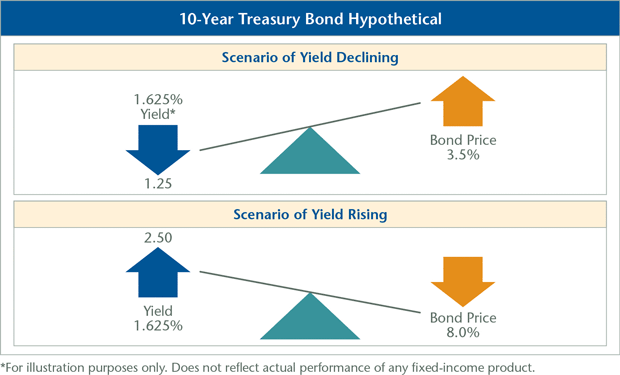How Bonds and Interest Rates Are Related
Post on: 22 Май, 2015 No Comment

Rising Rates Are Bad News if You Want to Sell a Bond Before Maturity
You can opt-out at any time.
Please refer to our privacy policy for contact information.
What happens to bonds when interest rates rise? This was representative of several questions posed in recent e-mails.
Bonds are an IOU or debt by the issuer to the bondholder.
When you invest in new bonds you are lending money to the issuer, whether that is a private company, a local or state governmental unit or, in the case of Treasury Bonds and Bills, the U.S. government.
Bondholders do not own a piece of the company, so they don’t get to vote on matters before the company.
However, bondholders are ahead of stockholders in payment when a company goes bankrupt. Stockholders typically lose everything when the company files for bankruptcy, while bondholders may receive some portion of their capital back.
Bond Different
Bonds are also different than stocks in how the value is calculated.
Most bonds pay a fixed interest rate for a fixed number of years and then repay the face value of the bond to the owner.
For example, if you bought a $10,000, 10-year bond that paid 5 percent interest you would receive interest payments of $500 per year for 10 years. At the end of the 10 years, the bond would return your investment – in this case, $10,000.
Some people buy newly-issued bonds from the issuer, while other buy bonds from other investors.
Newly-Issued Bonds
If you buy a newly-issued bond, you will receive the same interest payment every year until the bond matured regardless of what market interest rates do.
For example, a 10-year bond paying 5 percent interest will continues to make the same interest payment for the full 10 years.
However, if you buy a bond on the open or secondary market, a different set of circumstances comes into play.
For example, if you own a 10-year bond that pays 5 percent interest and want to sell it before its maturity, you must adjust the price to match current market rates.
If the current market rate is 6 percent, why would anyone want to buy your bond that only pays 5 percent?
Obviously, no one would. However, the market has a way of making adjustments so a bond paying 5 percent is as attractive as a bond paying 6 percent.
The interest rate is fixed and can’t be changes, so the only way to make you bond attractive to a potential buyer is to lower the price.
Bond Example
For example, if you have a 10-year bond paying 5 percent with a face value of $10,000, you would have to reduce the purchase price from $10,000 to a number that would equal the current 6 percent return.
Here’s how it works. You lower the price of your bond enough to make the 5 percent payment equal a 6 percent payment of the full amount.
When the bond matures, the new owner will receive the full face value — $10,000. Here’s an example:
If you own a bond paying 5 percent and the market rate is 6 percent, how much will you have to discount the face value ($10,000) so the fixed interest payment of $500 (5 percent of $10,000) is equal to the current market value of 6 percent?
The annual payment of $500 ($10,000 x 5%) must equal a 6% payment. Doing the math (5% divided by 6% = 0.8333), you discover that the face value of the bond must be discounted to $8,333 so that the $500 fixed payment equals a 6% yield on the buyer’s investment ($8,333 x 6% = $500).
If you bought the $10,000 face value bond paying 5% for $8,333, it would pay you $500 per year in interest, which is the equivalent of earning 6%.
Full Face Value
When the bond matures, you will receive the full $10,000 face value.
It is worth noting that if market interest rates have fallen since the bond was issued, the bond will sell at a premium (more than face value).
This is a simple example that does not take into account many factors such as brokers fees, potential tax consequence and so on.
There is a more sophisticated calculation that experienced bond brokers can perform that gets closer to your true yield if you hold the bond to maturity.
This is a long answer to the question about what happens to bonds if interest rates rise – as many expect will happen.
The short answer is in two parts:
First, if you hold the bond to maturity, nothing happens to the bond’s interest rate. You will receive the same annual payment.
Secondly, if you want to sell or buy a bond in the secondary market, the price will be calculated based on existing interest rates. If rates have risen, the bond will sell at a discount. If interest rates have fallen, the bond will sell at a premium.














